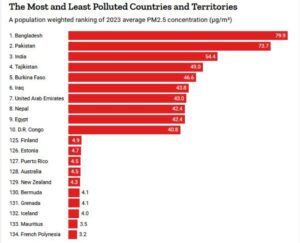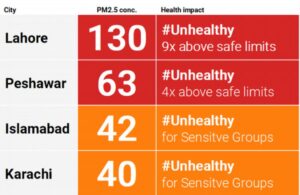South Asia, encompassing countries like Bangladesh, Pakistan, and India, is plagued by a severe air pollution crisis, with smog-choked cities and alarmingly high levels of particulate matter. Despite efforts to address this pressing issue, the region continues to grapple with deteriorating air quality, raising concerns about public health, environmental sustainability, and economic development. In this article, we delve into the factors contributing to South Asia’s air pollution problem and explore potential solutions to mitigate its detrimental effects.
Overview of Air Quality Report:
The World Air Quality Report for 2023, compiled by IQAir, revealed that South Asia ranked highest among regions with the poorest air quality. Bangladesh, Pakistan, and India emerged as the frontrunners in terms of recording exceptionally high levels of PM2.5, a hazardous fine particulate matter known to pose significant health risks.
Causes of Air Pollution:
Several factors contribute to the alarming levels of air pollution in South Asia:
Industrial Emissions: Brick kilns, factories, and other industrial activities release a cocktail of pollutants into the atmosphere, contributing substantially to air pollution.
Agricultural Practices: The widespread practice of crop burning, particularly after harvest seasons, releases harmful emissions and exacerbates air quality issues in rural areas.
Vehicle Emissions: The proliferation of vehicles, coupled with lax emission standards and inadequate public transportation infrastructure, results in high levels of vehicular emissions, especially in urban centers.
Geographic Factors: South Asia’s geographical features, such as its plains bordered by mountain ranges, create a natural trap for pollutants, leading to the accumulation of smog and haze.

Impact on Health and Society:
The detrimental effects of air pollution extend beyond environmental degradation, profoundly impacting public health and societal well-being:
Health Implications: Prolonged exposure to polluted air is associated with respiratory ailments, cardiovascular diseases, and other health complications, posing a significant risk to the region’s population.
Economic Consequences: Poor air quality exacts a heavy toll on the economy, with increased healthcare expenditures, productivity losses, and adverse effects on tourism and foreign investment.
Social Disruption: Smog emergencies, school closures, and work disruptions disrupt daily life, exacerbate social inequalities, and undermine overall societal resilience.
Government Initiatives and Challenges:
While governments in South Asia have taken steps to address air pollution, significant challenges persist:
Policy Measures: Governments have implemented measures such as banning crop burning, promoting renewable energy, and enforcing stricter emission norms to mitigate air pollution.
Enforcement Challenges: Weak enforcement mechanisms, inadequate monitoring infrastructure, and regulatory loopholes hamper the effective implementation of pollution control measures.
International Cooperation: Addressing transboundary pollution requires regional collaboration and international cooperation to tackle shared environmental challenges effectively.

Future Solutions and Outlook:
To combat South Asia’s air pollution crisis, concerted efforts are needed from all stakeholders:
Renewable Energy Adoption: Investing in renewable energy sources like solar and wind power can reduce reliance on fossil fuels and mitigate greenhouse gas emissions.
Sustainable Urban Planning: Enhancing public transportation, promoting cycling, and implementing pedestrian-friendly infrastructure can alleviate congestion and reduce vehicular emissions in urban areas.
Technological Innovations: Embracing innovative solutions such as air purifiers, emission control technologies, and smart monitoring systems can augment existing pollution control efforts and improve air quality monitoring capabilities.
Addressing South Asia’s air pollution crisis requires a multifaceted approach encompassing policy interventions, technological innovations, and behavioral changes. By prioritizing environmental sustainability, public health, and economic resilience, the region can work towards achieving cleaner air and a healthier future for its inhabitants. However, concerted efforts and collaboration at the national, regional, and international levels are imperative to overcome the formidable challenges posed by air pollution in South Asia.
















